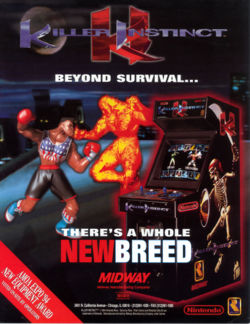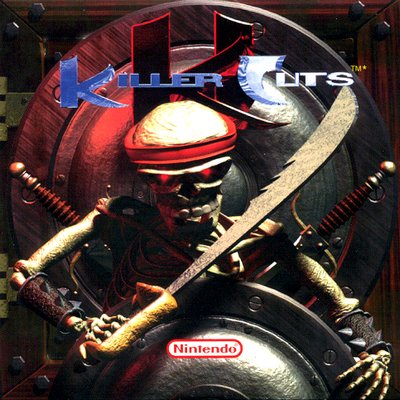Overview

Killer Instinct is a 2D sci-fi fighting game developed by Rareware and released by Nintendo (along with Midway) for arcades on October 28, 1994.
Set sometime in the near-future, Killer Instinct revolves around a powerful mega-corporation known as Ultratech, who organizes a special tournament (known as "Killer Instinct") to test the strength of their experimental prototypes among other combatants (who each have a special motivation to participate). The game is known for its unique multi-sequence combo system (with an ability to break out of opposing combos), a single-round, multi-lifebar system, and pre-rendered 3D graphics for character sprites, stages, and cutscenes, with the stages having a unique "camera pan" effect.
It is the first dedicated arcade game released by Nintendo since the Nintendo Vs. series and was planned to be developed with their Ultra 64 technology alongside Cruis'n USA, but was instead run on special Midway 64-bit proprietary hardware (which is known for being one of the earliest to utilize a connected hard disk drive, and also ran the game's 1996 sequel, Killer Instinct 2). The attract mode for the game also advertised that the game would be released for the Ultra 64 in 1995, which later turned out to be false due to the system's delay.
Throughout 1995, Killer Instinct was ported to the Super Nintendo Entertainment System and Game Boy. The SNES version is known for its black-colored cartridge, 2D parallax scrolling (with Mode 7 technology for the ground), new game modes, and pack-in soundtrack CD known as "Killer Cuts". The Game Boy version is known for its Super Game Boy support, including multiplayer on the same console. The SNES version was later included in the platform's Nintendo Switch Online service on February 21, 2024 (outside of Japan).
The game later received a downloadable port for the Xbox One as part of the late-2013 reboot of the series. Ported by Code Mystics and published by Microsoft, this version includes a new training mode, the ability to pick different arcade revisions, and online multiplayer. It can only be obtained by purchasing the "Season 1 Ultra Edition" (later the "Definitive Edition") of the reboot.
Gameplay
Killer Instinct plays similarly to other 2D fighting games at the time, with a six-button control layout similar to Street Fighter II (three punches and three kicks, organized into Quick, Middle, and Fierce strengths). However, its gameplay expands on the genre in several ways:
- Rather than traditional round-based matches, where the positions and vitality of both fighters reset after one player wins the round, the game uses two-stage life bars. The first time a combatant's life bar is depleted, it regenerates and the game continues after a quick pause.
- Its attack combo system is extensive and fine-tuned, with several types of attacks that can be used as the combo's "Opener", "Auto-Double", "Linker", and/or "Finisher". These can generate a large amount of hits with minimal button presses.
- To help counter repeat combo abuse, the game introduces "Combo Breaker" counter-attacks that, with proper timing and attack reading, can interrupt the combo with a damaging attack. Successful combo breaks also unlock enhanced variations of certain special moves.
- Along with cinematic end-of-match finishing moves (similar to the Mortal Kombat series), the game allows players to end their combo with one of two special match-ending Finishers once their opponent's life bar is flashing red (at <10% of their last vitality): the "Ultra Combo" (which ends with an flashy long-running sequence of attacks) and the "Ultimate Combo" (which ends with one of their violent "No Mercy" finishing moves).
- Similar to Mortal Kombat, fighters are put into a dizzied state once they lose all of their vitality, giving the opponent time to perform a finishing move. Successsfully recovering from the dizzy state (by wiggling the joystick and mashing buttons) puts the fighter in a special "Last Breath" state where they deal increased damage, although any damage to them (even chip damage) ends the match.
Combo System
Killer Instinct features a multi-sequence attack combo system whose structure encourages experimentation and mastery of both normal attacks and special moves, with specific button combinations extending the combo successfully. Each part of the combo follows one of four sequences:
- Openers are initial attacks that, if successful against a grounded opponent, leaves the opponent "open" to the combo. Along with certain special moves, these include jumping and overhead attacks.
- Auto-Doubles are normal attacks that, when performed successfully, automatically extend the combo with 2-4 additional attacks. These serve as the "glue" between Openers and Linkers, as well as between Linkers and Finishers. Certain attacks can only link from certain Openers and Linkers, with the general rule being QP <-> QK, MP <-> FK, and FP <-> MK.
- Linkers are extended special moves that can be performed after an Auto-Double, which can be linked back into the combo using another Auto-Double.
- Finishers, also known as "End Specials", are extended special moves that can be peformed after an Auto-Double to end the combo while either knocking opponents down or launching them into the air for additional juggling.
Each character has their own assortment of attacks that follow the above four, with a general combo being Opener -> Auto-Double -> Linker -> Auto-Double -> Finisher. These create lengthy combos with limited button presses. Higher-hit combos grant larger score, which are categorized as follows:
- 3 hits: Triple
- 4 hits: Super
- 5 hits: Hyper
- 6 hits: Brutal
- 7 hits: Master
- 8 hits: Awesome
- 9 hits: Blaster
- 10 hits: Monster
- 11 hits: King
- 12+ hits: Killer
On the defensive side, players can use their fighter's specific Combo Breaker special combination to attempt a counter-attack that can end the opposing combo and knock the attacker back. These can only be performed at the start of any Auto-Double, Linker, or Finisher, and the strength used against most of them must be of the next sequential strength the opponent used in a "rock-paper-scissors" fashion (MP/MK breaking QP/QK, FP/FK beating MP/MK, and QP/QK beating FP/FK). Successfully doing this also enables enhanced special moves, shown by the player's life bar showing a "spark" on it.
Match Finishers
Similar to the Mortal Kombat series, the game has finishing moves that can only be performed with a specific joystick and button combination during a quick time window once the opposing fighter drains their last life bar. Each combatant has two violent "No Mercy" finishers (also known as "Danger Moves") to choose from, although if the victor is still on their first life bar, they can opt to perform a "Humiliation" finisher instead (which forces their opponent fighter to dance).
Additionally, attackers can also finish their opponent as a Finisher to their final combo by inputting a specific combination as a Finisher when their opponent's life bar flashes red (under 10% left). These include the "Ultra Combo" (a knockout sequence consisting of 20+ hits) and the "Ultimate Combo" (which is one of their "No Mercy" finishers).
Characters
The game includes 10 playable characters and 1 unplayable boss.
- T.J. Combo - An American boxer who was once the undisputed heavyweight champion of the world (disgraced due to the reveal of his hidden use of Ultratech cybernetics). He fights in the tournament to regain his lost fame and fortune.
- Jago - A Tibetan warrior monk who, guided by the powerful "Tiger Spirit", seeks to destroy the evil within the tournament.
- Chief Thunder - A Native American tribal warrior (with mystical powers) who enters the tournament to uncover the mystery surrounding the disappearance of his brother.
- B. Orchid - An enigmatic secret agent sent by an unknown group to investigate mysterious disappearances surrounding the tournament.
- Cinder - A convicted criminal who participated in Ultratech's chemical weapons test known as "Project Cinder" and was mutated into a being of living flame due to a failed experiment. He was entered in the tournament with the promise of freedom.
- Sabrewulf - A German aristocrat who suffers from lycanthropy and remains as a recluse werewolf. He enters the tournament after being promised a cure. His name is likely a reference to the studio's earlier 1984 game Sabre Wulf (whose protagonist later developed lycanthropy himself in Knight Lore).
- Riptor - A genetically-engineered bioweapon created by Ultratech, combining human-level intellect with the reptilian ferocity and form of a velociraptor.
- Fulgore (sub-boss) - A prototype cybernetic soldier developed by Ultratech, entered into the tournament as a final test of its high-tech combat capabilities prior to its mass-production.
- Eyedol (final boss, only playable through cheat codes) - A demonic warlord who was released from his banishment by Ultratech to become the tournament's final challenge.
Soundtrack
 Killer Cuts front cover
Killer Cuts front coverKiller Cuts was a soundtrack album that was released and packaged with the video game Killer Instinct on the Super Nintendo in 1995. Many of the tracks were arranged and included the character's theme songs in addition to the songs featured in the fighting stages. Although exclusive to the pack-in with the game, it could be bought via the Nintendo Power magazine catalog.
- K.I. Feeling ( B. Orchid) - 3:45
- The Way U Move - 3:58
- Controlling Transmission ( Glacius) - 3:56
- Oh Yeah ( Chief Thunder) - 3:23
- It's a Jungle - 3:04
- Do It Now! ( Jago) - 3:55
- Full-bore ( Fulgore) - 3:16
- The Instinct (Theme) - 4:53
- Yo Check This Out! ( T.J. Combo) - 1:36
- Freeze - 2:11
- Trailblazer ( Cinder) - 1:50
- Tooth & Claw ( Sabrewulf) - 3:09
- Ya Ha Haa ( Spinal) - 3:00
- Rumble ( Riptor) - 2:11
- The Extreme ( Eyedol) - 2:33
Track 16 through 29 are blank and are only a few seconds in length. Track 30 is the song used in the Humiliation finishers/dances.
Log in to comment